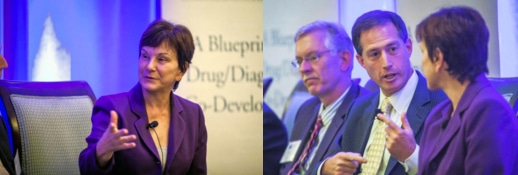In this 3rd installment of the Blueprint for Drug/Diagnostic Co-development, Friends of Cancer Research and Alexandria Real Estate Equities, Inc. brought together researchers, sponsors, advocates, and regulators to discuss possible approaches to expedite development of Next Generation Sequencing (NGS) as a companion diagnostic. Leading up to the event, a large collaborative group put together a report that proposes mechanisms to optimize NGS development and implementation.

L: Janet Woodcock / R: Jeff Shuren
In oncology, sequencing is on the cusp of transforming from a research tool into a clinical diagnostic tool. The technology has evolved to become affordable, accessible, and routine in many cancer centers. Karen Gutekunst (Illumina) explained, “because of the ability to deeply interrogate a patient’s tumor, using multiple markers at the same time from a small piece of tissue, it’s become a critical tool” that allows us to gain a better understanding of each patient. Between the complexity of cancer itself and the tools being used, many challenges still prevail. The first panel, moderated by Mya Thomae (Myraqa/Illumina), discussed opportunities for improvement.
What would a regulatory pathway look like to support the clinical paradigm of assessing multiple known actionable and emerging markers, as we shift away from the single companion diagnostic linked to a single drug model? Roman Yelensky (Foundation Medicine) pointed out that such a path would need flexibility to account for the rapidly changing science and drug development pipeline and stratify based on risk. While companion diagnostics will remain part of the Pre-Market Approval (PMA) pathway, Elizabeth Mansfield (FDA) inquired whether “special controls” could be put in place to allow certain markers to avoid the PMA pathway in the absence of sufficient data. One method of introducing controls is by categorizing markers based on available evidence, Omar Perez (Pfizer) described.

L-R: Mya Thomae, Karen Gutekunst, Roman Yelensky, Mickey Williams,
Omar Perez, Eli Ketchum, Elizabeth Mansfield
In the “wild west” of sequencing technologies, Mickey Williams (NCI) pointed out that while “DNA is DNA,” standardization and validation of the technology platform and reference material is key. Some areas of the genome are easy to sequence, others are difficult, and while it would be impossible to validate every genomic location, focusing on the most common and the most difficult areas to sequence may be a better approach. It would be invaluable for the community to harmonize and establish minimal reportable information for sequencing to allow standardization and reproducibility of results.
Additionally, the appropriate reference method and material, to ensure reproducibility of NGS results, should be identified to “find sequencing truth,” Eli Ketchum (Roche Sequencing) noted. A few efforts are already underway; NIST, Genome in a Bottle, has begun developing standardized reference material. Ultimately, patients should know the quality of evidence they are receiving without being confined to testing in a single lab. Several items remain outstanding: a study to determine which extraction methods could be applied across tumor types; a study to define sensitivity through determination of sample fraction of neoplastic versus normal tissue; a well curated database to allow for information sharing and learning because “eventually there’ll be enough evidence” such that we “can use everybody’s data to float everybody’s boat,” Elizabeth Mansfield (FDA).

L-R: Ramsey Baghdadi, Keith Flaherty, Steven Averbuch,
Bryan Loy, Jeff Shuren. Janet Woodcock
The second panel, moderated by Ramsey Baghdadi (RPM Report), discussed the current reimbursement challenges and NGS use in the healthcare setting. Keith Flaherty (Massachusetts General Hospital Cancer Center) described that “accountable care in cancer” requires standardization to pre-identify patients in the community who may benefit from referral to academic centers with large portfolios of clinical trials. In the academic centers, “we see a gradient of opportunity for patients with common actionable genetic alterations versus those whose tests reveal rare events. “Whose problem is it” to validate mutations for rare subgroups of patients: the sponsor, the academic, or the public sector? Professional societies, setting guidelines for best practices, could begin to address some of these outstanding issues.
One mechanism is to promote the use of “standing clinical trial networks that have standardized procedures and processes,” including the use of standardized platforms, instead of the current ad-hoc approach to unfold the complexity of the disease, described Janet Woodcock (FDA). Lung-MAP is a step in the right direction on this. Additionally, “the data management issues are systemic challenges not just for industry but the entire community” and standards need to be set high enough to ensure reproducibility so as not to waste dollars or patient resources. “What we [industry] want is a diagnostic that can identify patients for the right treatment, what we don’t want is the wrong answer”, said Steven Averbuch (Bristol-Myers Squibb). Through increased “transparency, collaboration and data availability, we’ll ultimately get there.”
Jeff Shuren (FDA), pointed out the need for greater linkage between the regulatory and reimbursement decisions, “there isn’t true patient access until there’s active reimbursement.” Unfortunately, however, “today, we don’t know what we’re paying for” said Bryan Loy (Humana); there is little knowledge about the quality of the test or the intent of use that can be obtained from claims data. Furthermore, payers have limited ability to assess the quality of the informed consent and communication of information to ensure patients are informed about their risk. Test-by-test CPT codes, used by insurers to identify diagnostics, to understand the nature of the mutation, the intent of use, or establish eligibility for a clinical trial, would be immensely helpful. NGS technology may lead to long-term cost savings by scaling up from the individual tests but may lead to undesirable clinical consequences.
The forum was a space for collaboration, open communication, and willingness to work together to find the right solutions. The panelists agreed, this cannot neglect the patient perspective; improving health literacy should take place ahead of any test. Patient preference and tolerance of benefit-risk tradeoffs is an important aspect of device development at FDA, Jeff Shuren noted.
To download the full whitepaper report released at the conference Click Here

